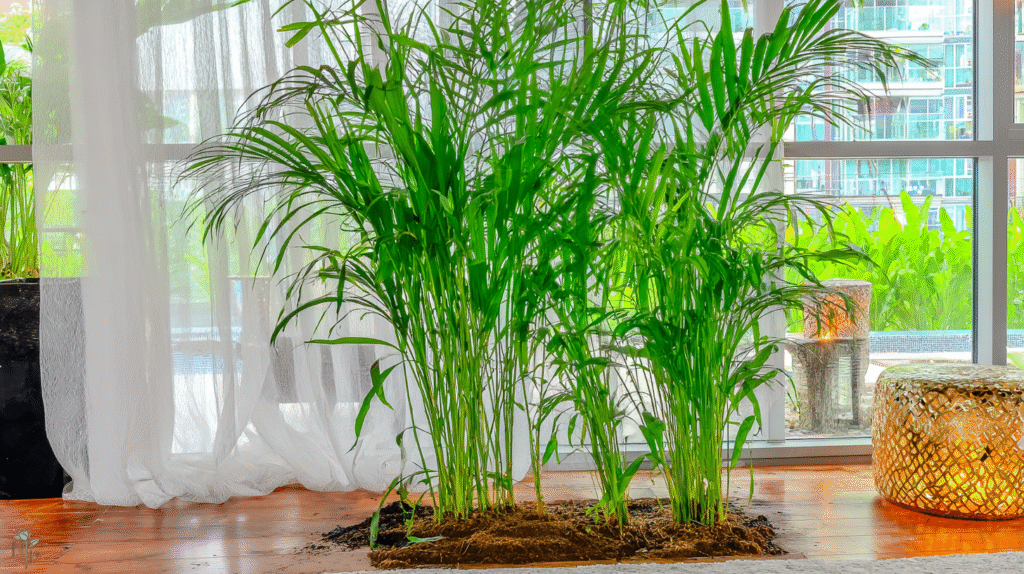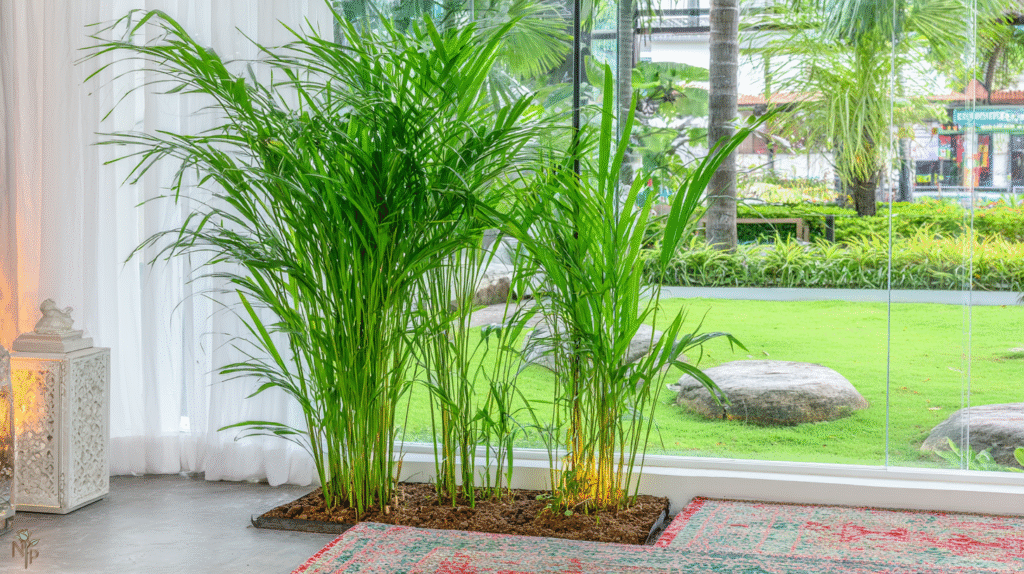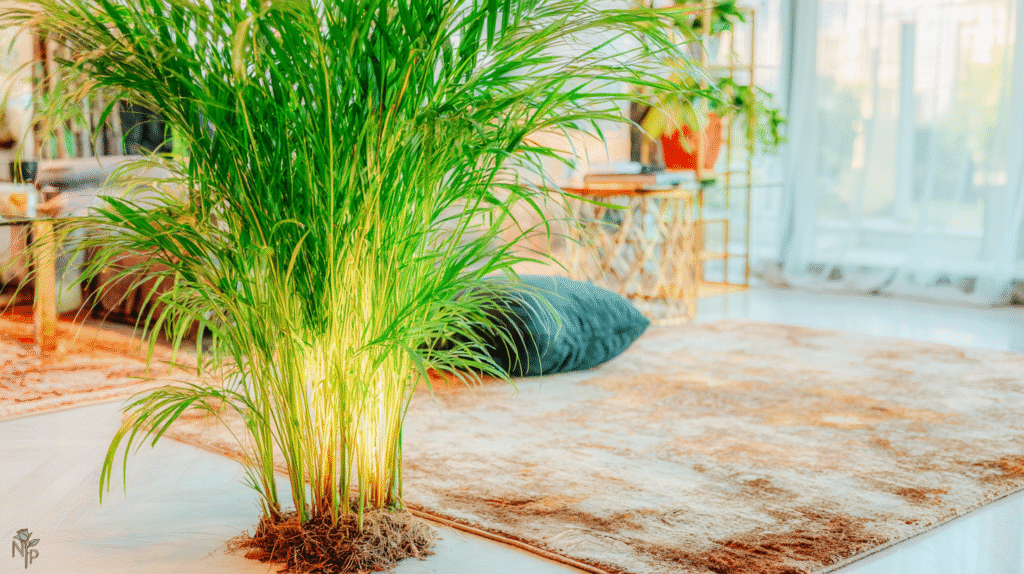The areca palm at Costco called to me like a siren. Six feet tall, lush green fronds, $39.99. “This will make my living room look like a boutique hotel!” I thought, wrestling it into my cart between the bulk toilet paper and rotisserie chickens.
Three weeks later, half those gorgeous fronds were brown and crispy. The tips looked like someone had taken a torch to them. My boutique hotel dreams had turned into what looked like a palm tree graveyard.
Turns out, areca palms (Dypsis lutescens) are drama queens disguised as easy-care plants. But here’s the thing — once I figured out their specific quirks, that half-dead Costco palm transformed into an 8-foot monster that people literally stop and compliment. Three years and two more arecas later, I finally understand what these tropical beauties actually need versus what the care tag claims.
Why Areca Palms Trick You Into False Confidence
Areca palms look sturdy. Those thick canes, those abundant fronds — surely they can handle normal houseplant life, right? Wrong. They’re actually incredibly particular about their environment, they just take forever to show it.
The slow decline pattern: Week 1-2: Looks amazing, you’re a plant genius Week 3-4: Few brown tips appear, probably nothing Week 5-6: Half the fronds have brown edges Week 7-8: Full plant meltdown, considering trash can
This slow burn is what tricks people. By the time you notice problems, your palm has been suffering for weeks. But once you understand their needs, they’re actually predictable and manageable.
Water: The Goldilocks Nightmare
This is where most people (including me) screw up first. Areca palms want their soil like that perfect morning coffee — not too hot, not too cold, but just right. Except with moisture.
Too much water:
- Yellow fronds
- Mushy canes at the base
- Root rot (game over)
- Fungus gnats partying
Too little water:
- Brown crispy tips
- Fronds folding inward
- Dry, sad appearance
- Slower death but still death
The sweet spot I finally found: Water when the top 2 inches are dry but deeper soil still has some moisture. For my big palm, that’s every 5-7 days in summer, every 10-14 days in winter. But here’s the kicker — I check with my finger every few days because conditions change.
My watering method: Water slowly until it drains out the bottom. Let it drain completely (crucial!). Never let it sit in standing water. That Costco palm almost died from root rot because I left the drainage tray full. Lesson learned.

Humidity: The Make-or-Break Factor
Want to know why your areca’s tips turn brown no matter what you do? Humidity. Or lack thereof. These palms want tropical humidity while living in our desert-dry homes.
My humidity journey:
- Misting daily: Useless, lasted 5 minutes
- Pebble trays: Helped maybe 5%
- Grouping plants: Better but not enough
- Humidifier: Game absolutely changed
That $40 humidifier saved my palms. Running it near my arecas keeps humidity around 50-60%. The difference? Night and day. Brown tips almost eliminated, growth exploded, fronds stay that deep jungle green.
Poor man’s humidity hacks:
- Bathroom placement if you have light
- Kitchen near the sink
- Group with other plants
- Double-pot with moist sphagnum between
But honestly? Just get a humidifier. Your palms (and sinuses) will thank you.
Light: Brighter Than You Think
The tag said “low to medium light.” The tag lied. Or at least stretched the truth. Areca palms will survive in medium light but look progressively sadder.
In low light:
- Sparse fronds
- Slow/no growth
- Susceptible to pests
- Generally depressed appearance
In proper bright indirect light:
- Lush, full growth
- Vibrant green color
- New fronds monthly
- Actually looks like the catalog photo
My living room palm struggled until I moved it 3 feet from a west window with sheer curtains. Not in direct sun (that causes different problems) but bright. The transformation took about two months but was dramatic.
The rotation ritual: Quarter turn every two weeks. Otherwise, it grows lopsided reaching for light. Learned this after my first palm looked like it was trying to escape out the window.
Temperature: Avoid the Extremes
Areca palms are tropical babies who hate surprises. They want steady temps between 65-75°F.
What kills them:
- Cold drafts from windows/doors
- Hot air from heating vents
- AC blowing directly on them
- Temperature swings
My first palm lived by the front door. Every winter opening sent cold air straight to it. Fronds went from green to yellow faster than autumn leaves. Moved it away from all drafts — problem solved.
Soil and Potting: Don’t Overthink It
After killing one palm with fancy “palm soil” that stayed too wet, I keep it simple:
My mix:
- 2 parts quality potting soil
- 1 part perlite
- 1 part orchid bark
Well-draining but still holds some moisture. Areca palms hate both extremes — swampy soil and bone dry. This mix threads the needle.
Repotting reality:
- Only when rootbound (2-3 years)
- One size up only
- Spring is best
- They sulk after repotting (normal)
That Costco palm came in a 14-inch pot. Three years later, it’s in a 16-inch pot. They don’t need frequent repotting and actually prefer being slightly snug.
Fertilizing: Less Drama Than Expected
Areca palms are hungry but not dramatically so.
What works:
- Balanced liquid fertilizer monthly in growing season
- Half strength to avoid burn
- Nothing in winter
- Occasional Epsom salt for magnesium
Signs they’re hungry:
- Yellowing older fronds
- Slow growth in summer
- Overall pale appearance
I overfed my first palm thinking more food = more growth. Nope. Got brown tips and sad fronds. Now I stick to monthly feeding April through September, nothing in winter. Simple and effective.
Common Problems I’ve Conquered
Brown tips everywhere:
- 90% humidity issue
- 10% fluoride in water
- Solution: Humidifier + filtered water
Yellow fronds:
- Old fronds yellowing = normal
- Multiple yellowing = overwatering
- Check roots if widespread
Scale insects:
- Brown bumps on stems
- Sticky residue
- Rubbing alcohol on cotton swab
- Check regularly
No new growth:
- Usually needs more light
- Could be rootbound
- Might be winter (normal)
Fronds drooping:
- Check water first
- Then check for pests
- Might need bigger pot

The Pruning Reality
Dead or dying fronds are normal. The key is knowing when and how to remove them.
When to prune:
- Completely brown/yellow fronds
- Broken or damaged fronds
- For shape (sparingly)
How to prune:
- Clean, sharp scissors
- Cut close to cane
- Never tear off
- Don’t overdo it
I used to freak out about every yellow frond. Now I know older fronds naturally die as new ones grow. Circle of palm life.
Creating the Perfect Setup
After all my mistakes, here’s what works:
Location: 4 feet from west window, away from vents Humidity: Humidifier keeping 50-60% Watering: Check twice weekly, water as needed Temperature: Steady 70-72°F Feeding: Monthly in summer, nothing in winter
This setup transformed my struggling palms into the lush specimens I dreamed about. No more crispy tips, no more yellow fronds, just tropical vibes.
Why I Keep Growing Areca Palms
They’re not the easiest houseplants. They demand specific conditions and throw tantrums when unhappy. But when an areca palm is thriving? Nothing else creates that instant tropical paradise feeling.
My living room went from basic to resort-like with one large areca. They clean the air, add humidity, and make every space feel more expensive than it is. Plus, once you dial in their care, they’re actually quite predictable.
That original Costco palm that almost died? It’s now the star of my living room, touching my 9-foot ceiling and producing new fronds monthly. Visitors always ask if it’s real. The $39.99 investment that almost went in the trash became the best plant purchase I’ve made.
Your Areca Success Plan
- Place in bright indirect light
- Invest in a humidifier (seriously)
- Water when top 2 inches dry
- Keep away from drafts
- Feed monthly in growing season
- Accept some browning as normal
- Be patient — they’re slow to show improvement
Areca palms will test your patience initially. But crack their code and you’ll have a stunning tropical showpiece that makes every day feel like a vacation. Just maybe skip the Costco impulse buy and start with a smaller one first. Learn from my almost-disaster. 🌴







